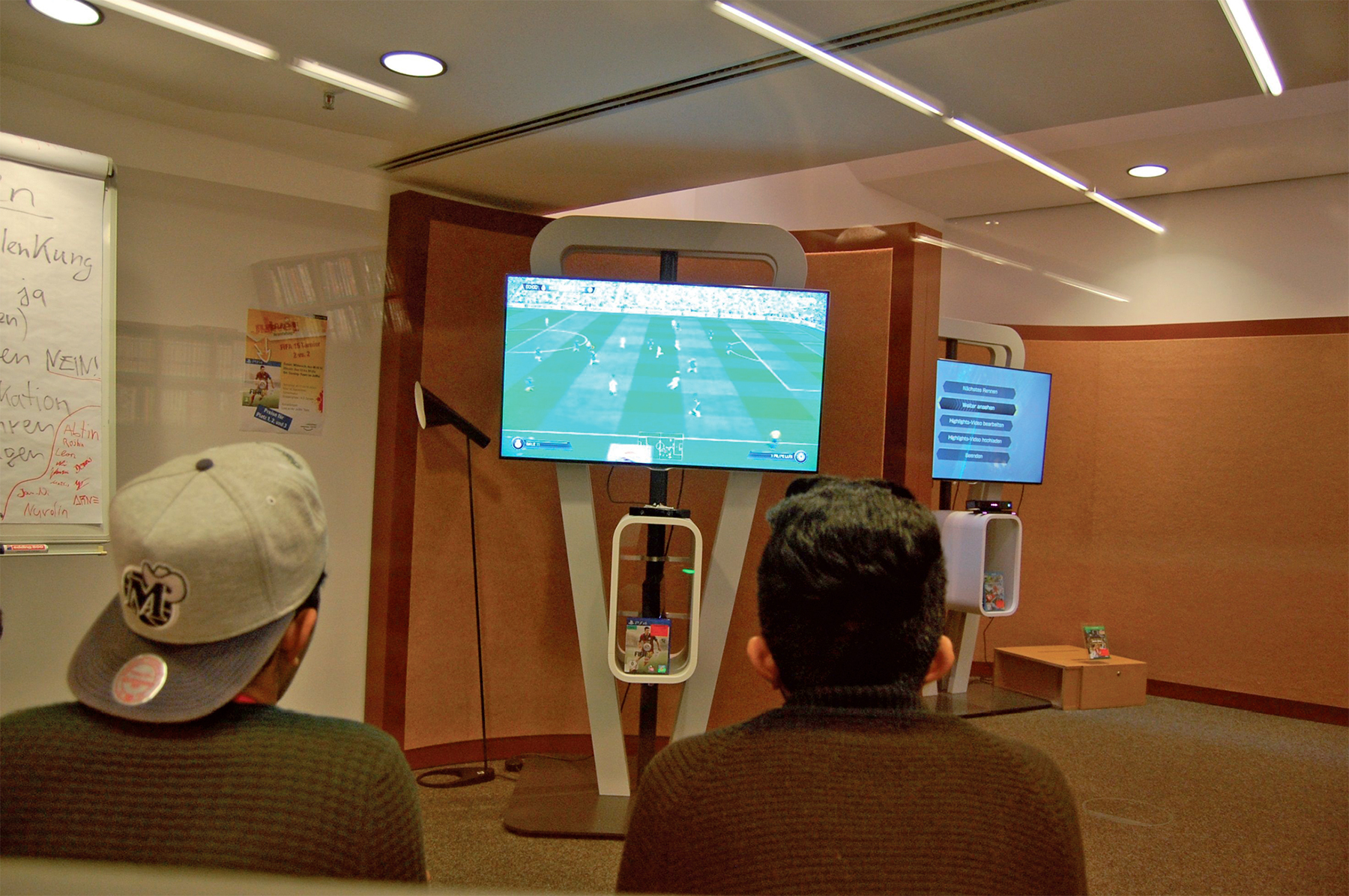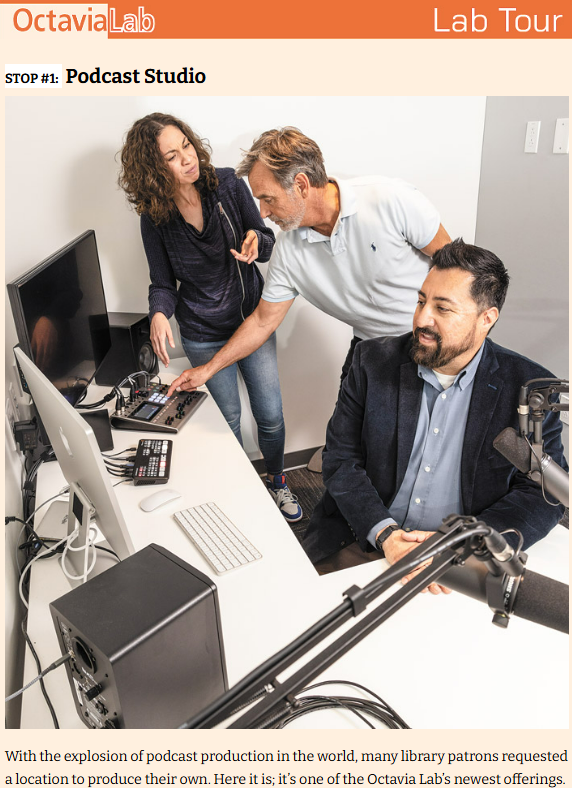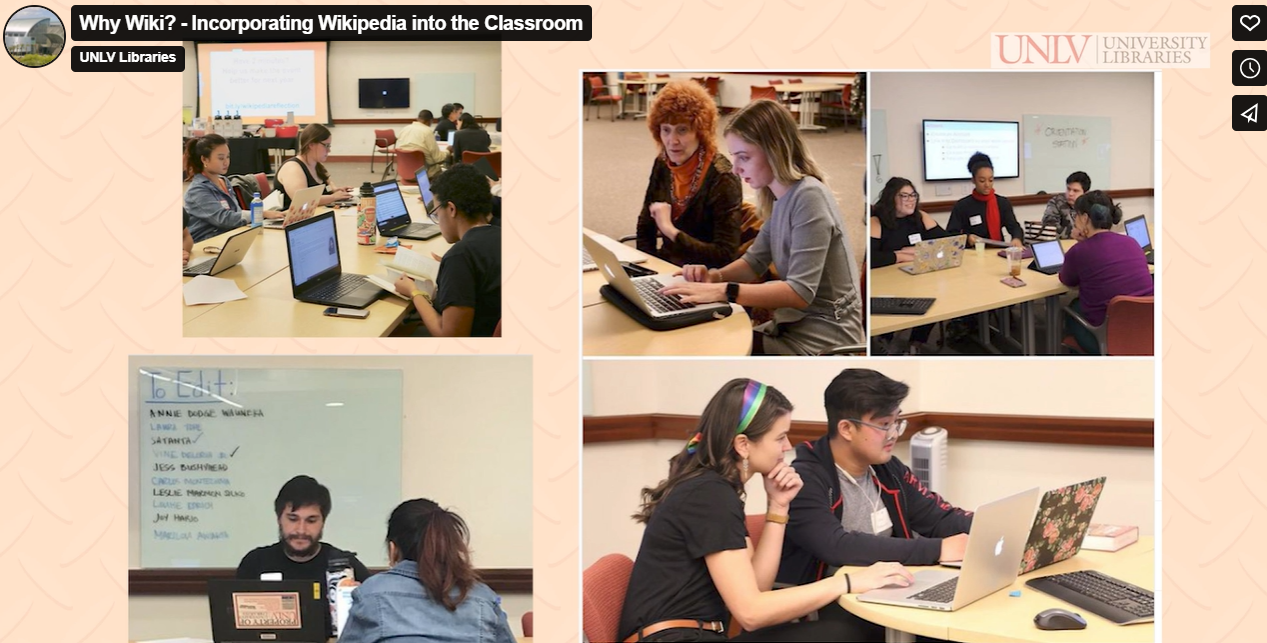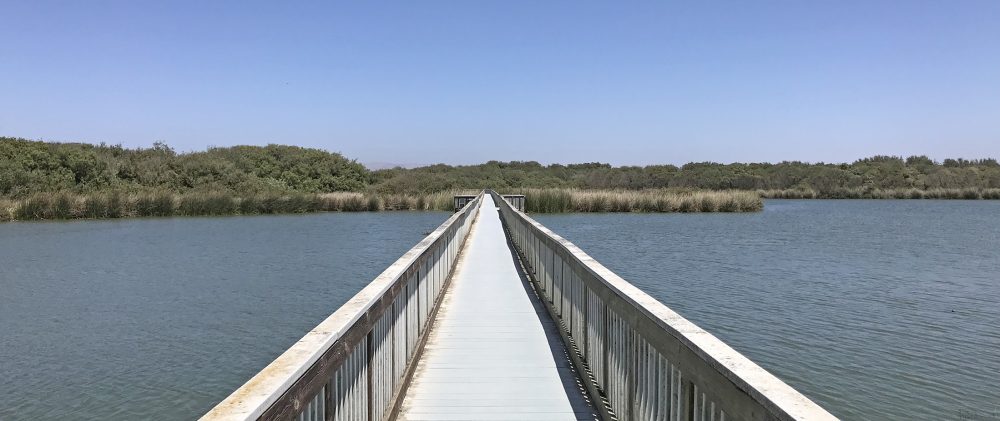
Patrons play FIFA soccer at the video game station in JuWel City Library in Münster, Germany. (Image Courtesy of Schönherr et al., 2016, p. 365).
Is there a concise term to describe a library which goes well beyond books? A moniker serving as a line of demarcation ahead of an era when library spaces become grounds for much more? Stephens (2019) offered that “Library 2.0 will be a meeting place, online or in the physical world, where my emotional needs will be fulfilled through entertainment, information, and the ability to create content to contribute to the ocean of content out there” (p. 5).
A constant shared between examples of library reimagining is a participatory nature, fostering community, contribution, and creativity. These avenues for enrichment are examples of “the four-space model” explained by Skot-Hansen (2016), as libraries can be redesigned to provide planned inspiration space, learning space, meeting space, and performative space to build “connections between people, experiences,” education, and creativity. Variations of this concept exist. For instance, Stephens (2019) conceptualizes five similar “zones with heart:” community, creativity, curiosity, collaboration, and caring (pp. 19–21).
This theme stood out as inspirational to me because, as inclinations toward eBook reading, streaming, and consumption of digitally delivered services evolve, opportunities are presented to rethink usage of floor space in library buildings. This dynamic leads me to react by questioning: How might we rethink such floor space? How can we leverage trends advantageously for user communities, both incumbent and potential?
While a growing “Library of Things” (ranging from farming equipment to sewing machines) will also play a role, with space and resources permitting, an expanding constellation of ideas for Library 2.0 can be categorized into such spaces and zones:
Inspiration Space (Creativity Zone)
- Podcast / AV Recording Lab
- Outdoor Gardening Boxes / Fruit & Vegetable Area
- 3D Printing / Makerspace / Carpentry Table
- “Memory Lab” (Digitization & Preservation of VHS, cassette tapes / scanning pictures / newsprint)
- 3D Modeling Labs
- Painting / Drawing / Sewing / Artistic Area
Learning Space (Curiosity Zone)
- Expert and/or Faculty Presentations (e.g., Financial Literacy, Banking, Home Owning, or Legal Advice Seminars / Partnerships with Doctors and Local Health & Medical Agencies)
- Mini-Art Museum / Historical Exhibits
- Tech Assistance for Seniors (e.g., smartphone tutorials)
- Wikipedia Edit-a-Thons
- Guitar Lessons
- Quiet Study Cubes
- Database Orientations
- “Human Library” / Personal Story Exchange
Meeting Space (Community Zone)
- Book Clubs / Discussion Groups
- Local Historical Presentations
- Video Game Station (non-competitive)
- Board Game / Card Game Area
- Author Book Signings / Local Celebrity Autograph Fundraisers
- Generalized Meeting Rooms (e.g., Coworking Offices)
- Group Study / Collaborative Marker-Board Rooms
- Naturalization Ceremonies
- Job Fairs
- Clothing Repair Sessions (e.g., patching, hemming)
- Cinema Club / Discussion Groups
- Comic Book / Pokémon / Sports Card / Coin Trading Events
- Movie Nights
- Coffee Shop / Café-Adjacent Seating Areas
Performative Space (Collaboration Zone)
- Music Recording Studio
- Trivia Nights
- eSports Mini-Arena

Octavia Lab manager Lauren Kratz and colleagues operate the podcast production studio at Los Angeles Public Library’s Central Library in 2023. (Image Courtesy of LAPL & Alive! by Glenn Marzano and Dearbhla McNulty)
Through offering services such as these ideas and similar programs, we can reshape libraries into even more dynamic environments for learning and building community. Here, I’ll briefly highlight a trio of these ideas already exemplified, where we are seeing this theme show up in practice:
The Los Angeles Public Library’s Octavia Lab is a prime example of this type of participatory, vocal manifestation. The lab provides two podcast/livestream studios equipped with iMacs, “podcast recorder[s], two microphones, and a video switcher for live streaming,” along with several supporting resources (Los Angeles Public Library, 2025).
The video game stations offered at JuWel City Library in Münster, Germany, are another instance of Library 2.0, as multiplayer modes are provided to youth to “play together with friends” on PlayStation, Xbox, and Wii platforms for games like FIFA soccer and Mario Kart (Schönherr et al., 2016/2024, pp. 364–365).
Meanwhile, the UNLV Library has epitomized educational and contributory participation through its series of Wikipedia Edit-a-Thon events. On a yearly basis since 2018, UNLV has hosted such sessions, including “Art + Feminism” in 2025, resulting in 22 editors logging 52 edits, more than a 2,000-word expansion, and the addition of 18 references to 24 articles (UNLV Libraries, 2025). A library hosting community members for this kind of Wiki Edit-a-Thon “fosters social connection — creating, contributing, [and] sharing” (Pink & Shirkey, 2010).
Personally, consuming podcasts, playing video games, and editing and creating Wikipedia articles have all become experiences leading to my own learning, fun, and finding community. No matter the line of LIS work in which I land, my future goals include helping to provide participatory environments built to facilitate such educational, enjoyable, and connective times.

The UNLV Library hosts annual Wikipedia Edit-a-Thon events. (Image Courtesy of UNLV Vimeo)
References
Los Angeles Public Library. (2025). Podcast/livestream studios | Los Angeles Public Library. City of Los Angeles. https://www.lapl.org/labs/octavia-lab/podcast
Pink, D., & Shirkey, C. (2010). Cognitive surplus: The great spare-time revolution. Wired. https://www.wired.com/2010/05/ff-pink-shirky/
Schönherr, U., Geraedts, A., & Kreuzheck, A. (2016). Ein JuWel ist entstanden. [A jewel has been created]. Bibliothek Forschung Und Praxis, 40(3), 361–369. https://doi.org/10.1515/bfp-2016-0061
Skot-Hansen, D. (2016) Library development: From collection to connection. University of Copenhagen, Faculty of Humanities. https://humanities.ku.dk/collaboration/impact/library-development/
Stephens, M. (2019). Wholehearted librarianship: Finding hope, inspiration, and balance. American Library Association.
UNLV Libraries. (2025). Resources from past events – Wikipedia edit-a-thon – libguides at University of Nevada, Las Vegas. Lied Library. https://guides.library.unlv.edu/wikiedit/resources
